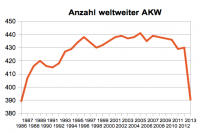AKTUALISIERUNG 21.1.2013:
Die IAEA hat die Ummeldung von 47 Japanischen Atomreaktoren als langfristig außer Betrieb (“Long-Term Shutdown”) zurückgenommen. Diese Reaktoren gelten jetzt also wieder als „in Betrieb“, obwohl sie seit über einem Jahr keinen Strom erzeugen.
Hier der Kommentar von Mycle Schneider: (en)
https://www.worldnuclearreport.org/IAEA-Japan-Reactor-Status-Incident.html
—————————————-
Die weltweite Atomaufsichtsbehörde IAEA (deutsch IAEO) hat überraschend faktisch die Atomwirtschaft in Japan beendet. 47 von 61 AKWs wurden auf den Status „Long-Term Shutdown“ (Dauerabschaltung) eingestuft, eines hatte diesen Status bereits zuvor, 9 AKWs sind bereits endgültig abgeschaltet. Damit sind derzeit nur noch 3 AKWs in Betrieb, 2 weitere sind noch in Bau. Dadurch wurde gleichzeitig die Zahl der weltweit in Betrieb stehenden AKWs um 10 % auf 390 verringert.
————————————
IAEA: 47 japanische Reaktoren im “Langzeitstillstand”
Ein historischer Erfolg: die Internationale Atomenergie-Organisation sieht offenbar ein Wiederanfahren der vielen japanischen Atomreaktoren, die nach dem GAU von Fukushima abgeschaltet wurden, nicht in Sicht. In der Datenbank “Pris” wurden jetzt 47 Meiler mit dem Status “longterm-shutdown” (Langzeit-Stillstand) versehen.
Anzahl AKW weltweit, Stand: 16.01.2013
Der Wahlausgang in Japan liess Atombefürworter aufatmen: Sie war Ende Dezember erst wenige Tage im Amt, da verkündete die neue Regierung, Japan setze wieder auf die Atomkraft. Der neue Premier Shinzo Abe will damit Abstand vom Atomausstieg nehmen, den die Vorgängerregierung nach der Katastrophe von Fukushima beschlossen hatte. 47 Meiler stehen still. Drei Reaktoren befinden sich trotz des Protestes tausender Menschen wieder in Betrieb.
Nun hat offenbar auch die Internationale Atomenergie Organisation die Hoffnung vorerst aufgegeben, dass es zu einem zeitnahen Neustart des japanischen Atomprogramms kommt: alle 47 Reaktoren wurden in der offiziellen Datenbank “Power Reactor Information Service” (PRIS) auf den Status “longterm shutdown” gesetzt. Grundsätzlich ist dieser Status Anlagen vorbehalten, die teilweise für Jahre oder Jahrzehnte für Instandsetzungsarbeiten abgeschaltet werden.
Damit befinden sich weltweit laut IAEO noch 390 Atomreaktoren in Betrieb. Zuletzt waren 1986 – im Jahr des Tschernobyl-Unfalls – vergleichbar viele AKW in Betrieb.
Grafik AKW in Japan, Stand: 16.01.2013; Quelle: iaea.org
Quelle: https://www.contratom.de/2013/01/16/iaea-4-japanische-reaktoren-im-langzeitstillstand/
———————————————-
Historic Move: IAEA Shifts 47 Japanese Reactors Into “Long-Term Shutdown” Category
Wednesday 16 January 2013
In an unprecedented move, the International Atomic Energy Agency (IAEA) has shifted 47 Japanese nuclear reactors from the category “In Operation” to the category “Long-term Shutdown” (LTS) in its web-based Power Reactor Information System (PRIS). The number of nuclear reactors listed as “In Operation” in the world thus drops from 437 yesterday to 390 today, a level last seen in Chernobyl-year 1986 and a dramatic step of the IAEA’s official statistics in recognizing industrial reality in Japan. This is without doubt a unique revision of world operational nuclear data.
However, numerous questions remain. The definitions of the IAEA’s reactor status categories remain unclear. Units can remain in the LTS category for many years, without any apparent limit. Japan has now 48 units listed as LTS, one of which is the fast breeder reactor Monju that has not been generating electricity since a sodium fire severely damaged the plant in 1995, while three further units at Kashiwazaki-kariwa have not been generating power since an earthquake hit the site in 2007.
Of the other 47 Japanese units, 42 have been retroactively classified as LTS as of 1 January 2012 (strangely including the 3 Kashiwazaki-kariwa units), while five reactors have retroactively entered that listing between 14 January and 26 March 2012. One reactor, Tomari-3 in Hokkaido—the last one to generate electricity before the country entered a two-month nuclear-free period between 5 May and 5 July 2012—remains, for unknown reasons, in the categories “In Operation” (world overview) and “Operational” (country file). This is despite the fact that only two reactors are currently effectively generating power in Japan, units 3 and 4 at the Ohi plant in Fukui Prefecture.
The future of the Japanese nuclear power plants remains highly uncertain. In spite of a clearly more pro-nuclear government that came in with the election of Prime Minister Shinzo Abe, it will likely take years until more power plants could get back on line. Abe stated on 4 January 2013:
„We will first of all determine whether or not to restart nuclear power plants on the basis of scientific safety standards. Then over the course of roughly three years we will assess the futures of existing nuclear power plants and transition to a new stable energy mix over ten years. The new construction or replacement of nuclear power plants is not a matter that is able to be determined immediately. Naturally this is an area in which we should make our determination in accordance with the principle of gradually decreasing our degree of reliance on nuclear power to the greatest extent possible.“
Other sources have also suggested that it could take a long time for nuclear plants to adapt after the newly established Nuclear Regulatory Authority will come up with new safety standards in July 2013.
Quelle: https://www.worldnuclearreport.org/spip.php?article132

